Field marshal
Field marshal (or field-marshal, abbreviated as FM) is the most senior military rank, ordinarily senior to the general officer ranks. Usually it is the highest rank in an army and as such few persons are appointed to it. It is considered as a five-star rank (OF-10) in modern-day armed forces in many countries. Promotion to the rank of field marshal in many countries historically required extraordinary military achievement by a general (a wartime victory). However, the rank has also been used as a divisional command rank and also as a brigade command rank. Examples of the different uses of the rank include Austria-Hungary, Pakistan, Prussia/Germany, India and Sri Lanka for an extraordinary achievement; Spain and Mexico for a divisional command (Spanish: mariscal de campo); and France, Portugal and Brazil for a brigade command (French: maréchal de camp, Portuguese: marechal de campo).

The origin of the term dates to the early Middle Ages, originally meaning the keeper of the king's horses (from Old German Marh-scalc = "horse-servant"), from the time of the early Frankish kings. The exact wording of the titles used by field marshals varies: examples include "marshal" and "field marshal general". The air force equivalent in Commonwealth and many Middle Eastern air forces is marshal of the air force (not to be confused with air marshal). Navies, which usually do not use the nomenclature employed by armies or air forces, use titles such as "fleet admiral," "grand admiral" or "admiral of the fleet" for the equivalent rank. The traditional attribute distinguishing a field marshal is a baton. The baton nowadays is purely ornamental, and as such may be richly decorated. That said, it is not necessary for the insignia to be a baton (Such is the case in Russia post-1991 and the former Soviet Union, which use a jewelled star referred to as a Marshal's star).
Field marshal ranks by country
Afghanistan
Sardar Shah Wali Khan (d. 1977) of the Musahiban and uncle of King Mohammad Zahir Shah and President Mohammed Daoud Khan, was a field marshal. Mohammed Fahim became a honorary marshal in 2004.[1]
Australia
The first appointment to the rank was Sir William Birdwood, who received the honour in March 1925. Sir Thomas Blamey was the second appointment to the rank, and was the first and so far only Australian-born field marshal. He was promoted to the rank on the insistence of Sir Robert Menzies, the Prime Minister of Australia, in June 1950. His field marshal's baton is on display in the Second World War galleries at the Australian War Memorial in Canberra. The third appointment, and the only living Australian field marshal, is Prince Philip, Duke of Edinburgh, who was promoted to the rank on 1 April 1954.
Brazil
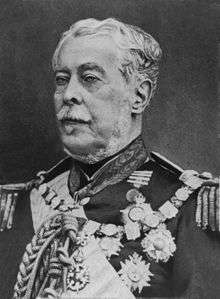
When Brazil became independent from Portugal in 1822, the Portuguese system of ranks was maintained by the Brazilian Army, including the rank of marechal de campo. In the second half of the 19th century, the rank of marechal de campo was replaced, both in Portugal and Brazil, by the rank of general de brigada (brigade general). This last rank still exists today in the Brazilian Army, but corresponds to the present rank of major-general (major-general) in the Portuguese Army. Today, the Rank of Marechal is the maximum rank available but only awarded during wartime. The Brazilian Air Force has the similar rank of Air Marshal.
China
During Imperial rule in China, different dynasties gave different titles to generals. A very similar title is "司馬" (sima) in the Eastern Han dynasty, which literally means "master of horse", and later became a two-character surname too. "司馬" is one of the Three Excellencies in Eastern Han, who is in charge of the country's military affairs. Later, a more common title for a field marshal or a commandant was (元帥 Yuan Shuai) or grand field marshal (大元帥 da yuan shuai). One of the most famous of these generals was Yue Fei from the Song Dynasty. Since the People's Republic of China was established in 1949, it has promoted 10 military commanders to the rank of marshal, all in 1955 and abolished in 1965. Since then, the rank has remained defunct.
Egypt
The Arab Republic of Egypt has had (9) field marshals. Currently there are two living field marshals; ex military commander in chief Mohamed Hussein Tantawi (Active Duty) and President Abdel Fattah el-Sisi (Active Duty). Previous field marshals are Abdel Hakim Amer (Active Duty), Ahmad Ismail Ali (Active Duty), Mohamed Abdel Ghani Elgamasy (Active Duty), Abd al-Halim Abu Ghazala (Active Duty), Mohammed Aly Fahmy (honorary), Ahmed Badawi (posthumously), and Admiral. Fouad Mohamed Abou Zikry (honorary).
Finland
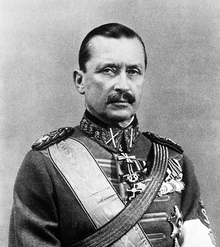
Carl Gustaf Emil Mannerheim was promoted to Field Marshal in 1933. In 1942 he was promoted to Marshal of Finland, which really is not a distinctive military rank but an honour.
France
In the French army of the Ancien Régime, the normal brigade command rank was field marshal (maréchal de camp). In 1793, during the French Revolution, the rank of field marshal was replaced by the rank of brigade general. The rank insignia of field marshal was two stars (one-star being used for a senior colonel rank). The French field marshal rank was below lieutenant-general, which in 1793 became divisional-general. In the title maréchal de camp and the English "field marshal", there is an etymological confusion in the French camp between the English words "camp" and "field". The French rank of field marshal should not be confused with the rank of Marshal of France, which has been the highest rank of the French Army since the higher dignity of Marshal General of France was abolished in 1848 (although in theory it is not an actual rank but a "state dignity").
German-speaking lands

Generalfeldmarschall (general field marshal, field marshal general, or field marshal / ![]()
Greece
.svg.png)
Stratarches (Greek: Στρατάρχης), meaning Ruler of the Army in Greek, is a title for senior military commanders dating back to classical antiquity, in the sense of "commander-in-chief". In modern Greek usage, it has been used to translate the rank of Field Marshal. In this sense, the rank was borne by the Kings of Greece since 1939, and has been awarded only once in modern Greek history to a professional officer: Alexandros Papagos in 1949 for his leadership in the Greek victory against Fascist Italy in World War II and against the Communist forces in the Greek Civil War. The rank is not retained by the current (since 1974) Third Hellenic Republic.
India

Field marshal is the highest attainable rank in the Indian Army. It is a ceremonial / war time rank. There have been two Indian field marshals to date: Kodandera Madappa Cariappa, the 1st Indian Chief of Army Staff of the Indian Army in 1986 (much after his retirement), and Sam Manekshaw in 1973.[2]
Libya
Khalifa Haftar was the first to receive this rank in Libya from the House of Representatives (Libya) in 2016 after the liberation of oil ports in the Operation Swift Lightning.[3]
Pakistan

Ayub Khan (1907-1974) was the only field marshal in the history of Pakistan. He was the second president of Pakistan and the first native commander in chief of the army.
Philippines
US Army General Douglas MacArthur was the first and only field marshal in the history of the Philippine Army, a position he held while also acting as the Military Advisor to the Commonwealth Government of the Philippines with a rank of major general. President Quezon conferred the rank of field marshal on 24 August 1936 and MacArthur's duty included the supervision of the creation of the Philippines nation-state.
Portugal
In the Portuguese Army, the rank of marechal de campo was created in 1762, as the most junior general officer rank. Hierarchically, it was between the rank of tenente-general (lieutenant-general) and the rank of brigadeiro (brigadier), this last one not being considered a general rank, but a kind of senior colonel.
In Portugal, the ranks of marechal-general (marshal-general) and marechal do Exército (marechal of the Army) or simply marechal also existed. Distinctively from the rank of marechal de campo, the ranks of marechal-general and marechal were the highest in the Portuguese Army, usually being reserved for the commanders-in-chief of the Army. Latter, the rank of marechal-general became reserved for the Monarch, as a mere honorary dignity.
Romania
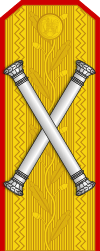
Mareșal is the highest rank in the Romanian Armed Forces. The rank of mareșal can only be bestowed to a General or Admiral (Romanian: amiral), in time of war for exceptional military merits, by the President of Romania and confirmed by the Supreme Council of National Defense.
Serbia and Yugoslavia
In Serbian, field marshal can be translated as Бојни Маршал, Bojni Marshal, and in Serbia and Yugoslavia it was similar to rank Vojvoda (Serbia and Yugoslavia) that has some similarities compared to Generalfeldmarschall, Marshal of France and Field marshal (United Kingdom) but also differs in way of promotion, duration and style. It was the highest rank in the army of the Kingdom of Serbia and Kingdom of Yugoslavia until the Second World War. It was first created with the passing of the law on the Organization of the Army of the Kingdom of Serbia in 1901. The law was passed on the suggestion of Lieutenant Colonel (later Divisional General) Miloš Vasić who was minister of defense at the time. The rank was awarded only during the war for particular military contributions of top generals and as honorable title. Yugoslav People's Army had rank of Marshal used only by Josip Broz Tito as supreme commander, for more details see Marshal of Yugoslavia.
Sri Lanka
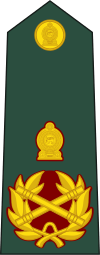
Field Marshal is the highest rank in the Sri Lanka Army. It is a ceremonial rank. Sarath Fonseka is the first and, to date, only Sri Lankan officer to hold the rank. He was promoted to the position on 22 March 2015.[4]
Thailand
.svg.png)
In the Royal Thai Army the rank of Chom Phon (Thai: จอมพล, จอมพลทหารบก) was created in 1888, together with all other military ranks along western lines, by King Chulalongkorn. Until the first appointment in 1910, the rank was reserved solely for the reigning monarch. Currently the rank is in abeyance.
Turkey
In the Turkish Armed Forces, the corresponding rank is mareşal. Its origins can be traced to the Ottoman Empire and to the military of Persia, where it was called "مشير" (müşir)[5] and bestowed upon senior commanders upon order of the ruling sultan. The rank of mareşal can only be bestowed by the National Assembly, and only given to a general who leads an army, navy or air force successfully in three battles or at various front lines at the same time, gaining a victory over the enemy. Only two persons have been bestowed the rank: Kemal Atatürk, the founder of modern Turkey, and his Chief of Staff Fevzi Çakmak, both for their successes in the Turkish War of Independence.
Uganda
Field Marshal Idi Amin was the military dictator and third president of Uganda from 1971 to 1979. Amin joined the British colonial regiment, the King's African Rifles in 1946, serving in Somalia and Kenya. Eventually, Amin held the rank of major general in the post-colonial Ugandan Army and became its commander before seizing power in the military coup of January 1971, deposing Milton Obote. He later promoted himself to field marshal while he was the head of state.
United Kingdom
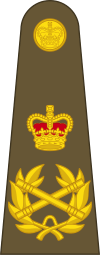
Arthur Wellesley, 1st Duke of Wellington, held the rank of a field marshal, or equivalent rank, in eight armies. Nine of his field marshal batons are on display in Apsley House (see Batons of Arthur Wellesley, 1st Duke of Wellington).
United States
No branch of the United States Armed Forces has ever used the rank of field marshal. However, General Douglas MacArthur was commissioned a field marshal of the Philippine Army in 24 August 1936, serving until 31 December 1937, while still a serving United States Army officer. On 14 December 1944, Congress created the rank of "general of the army", a five-star rank equivalent to that of field marshal in other countries. Two days later, George Marshall was promoted to this rank, becoming the first five-star general in American history. A Washington columnist suggested (with tongue in cheek) that Marshall disliked the plan because five stars was the rank of field marshal and the Chief of Staff could then be addressed as "Marshal Marshall".[6]
Other nations

- Marshal of the Empire (First French Empire)
- Feldmarschall (Austro-Hungarian monarchy)
- Stožerni general (Croatia)
- Marshal of Italy
- Rav-Aluf (Israel)
- Wonsu (DPRK, ROK)
- Fil Marsyal (Malaysia)
- Field marshal (New Zealand)
- Marshal of Peru
- Marshal of Poland
- General field marshal (Imperial Russia)
- Marshal of the Russian Federation
- Marshal of the Soviet Union
- Fältmarskalk (Sweden)
- Chom phon (Thailand)
See also
- Admiralissimo
- Generalissimo
- Grand marshal
- List of field marshals
- List of German field marshals
- General of the Army
- Admiral of the Navy
- General of the Air Force
Notes
References
- https://fotw.info/flags/af_mfndu.html
- "Did You Know That Only 3 People Have Been Given The Highest Ranks In The Indian Armed Forces?". Archived from the original on 4 January 2017.
- "Profile: Libya's military strongman Khalifa Haftar". 15 September 2016. Archived from the original on 27 February 2018. Retrieved 8 May 2018 – via www.bbc.com.
- SureshikaThilakarathna. "Sarath Fonseka promoted Sri Lanka's first ever Field Marshal". news.lk. Archived from the original on 11 July 2017. Retrieved 8 May 2018.
- "Great Turkish Dictionary". Turkish Language Association. Retrieved 1 August 2009.
- "Eisenhower Memorial Commission – The Story Behind Ike's Fifth Star". Eisenhowermemorial.org. Archived from the original on 17 July 2012. Retrieved 14 May 2012.
External links

.svg.png)
